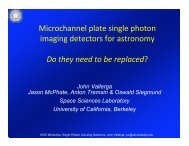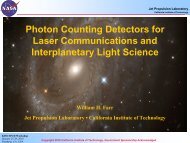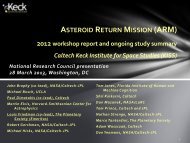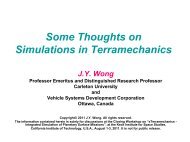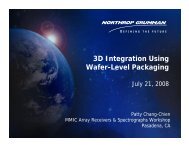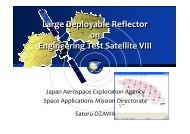Lai - Keck Institute for Space Studies
Lai - Keck Institute for Space Studies
Lai - Keck Institute for Space Studies
- No tags were found...
Create successful ePaper yourself
Turn your PDF publications into a flip-book with our unique Google optimized e-Paper software.
Recent NGST HEMT Device & MMIC<br />
Development<br />
MMIC Array Receivers and Spectrographs<br />
Workshop<br />
Richard <strong>Lai</strong> and Xiao-Bing (Gerry) Mei<br />
Northrop Grumman Corporation, Redondo Beach CA, 90278<br />
July 21, 2008
HEMT Technology Development Applicable<br />
towards Radiometric Applications at NGST<br />
• NGST Internal R&D<br />
– Yearly budget > $2M <strong>for</strong> last 10 years<br />
– First LNAs at various frequencies including 90, 140, 150, 180, 240 GHz<br />
– First 30 dB gain 160-190 GHz amplifier block and full radiometer<br />
• DARPA<br />
– MIMIC Phase II W-band GaAs HEMT LNA<br />
– TRP W-band MMW Camera<br />
– MAFET MMW InP HEMT MMIC production<br />
– SWIFT – 340 GHz Transceiver<br />
– Hi-Five – 220 GHz Driver<br />
• JPL CHOP – focused development of InP HEMT croyogenic LNAs<br />
– FCRAO 94 GHz LNA UMass Amherst<br />
– European <strong>Space</strong> Agency – ground telescopes MMW LNAs, PINs<br />
– GEOSTAR, 183 GHz SAR<br />
– Deep <strong>Space</strong> Network, Paul Allen Telescope, Hawaii MMW LNAs<br />
• Projects<br />
– Jason (TOPEX/Poseidon) Ka-band LNAs<br />
– ODIN, IMAS, MLS (120 GHz flight)<br />
– Cloudsat (W-band)<br />
– PLANCK and Herschel (MMW, W-band power)<br />
– ALMA (NRAO, X-band LNAs, W-band power)<br />
– CSIRO (Austrailia): Narrabri telescopes, VLA (MMW to 200 GHz)<br />
– NOAA (ATMS, CMIS) development (MMW to 200 GHz)<br />
– LRR (Goddard – X-band)<br />
– NRL G-band MMIICs<br />
MLS<br />
Herschel<br />
Planck<br />
Odin Module<br />
W-band MMW Camera<br />
2
InP HEMT<br />
Source<br />
Cap<br />
Donor<br />
Channel<br />
Buffer<br />
Substrate<br />
Gate<br />
In 0.53 Ga 0.47 As<br />
In 0.52 Al 0.48 As<br />
In x Ga 1-x As<br />
Drain<br />
Semi-Insulating InP<br />
Silicon<br />
doping<br />
Cutoff Frequency fT (GHz)<br />
400<br />
300<br />
200<br />
100<br />
0<br />
100 nm gate<br />
GaAs<br />
InP<br />
0.0 0.2 0.4 0.6 0.8 1.0<br />
X {In x Ga (1-x) As}<br />
Features<br />
• Pseudomorphic growth of InP HEMT layers with MBE<br />
• Mobility, fT improve with higher Indium composition<br />
• Single recess, semi-selective etch process<br />
• SiNx passivation<br />
• 2-level interconnect metal process with airbridges, TFR and MIMCAP<br />
• 50 um thick chips with through via process<br />
High Indium<br />
Composition
InP HEMT Device Structure<br />
INDUCTOR<br />
AIRBRIDGE<br />
TFR<br />
MIM<br />
Epitaxial Material<br />
Isolated Material<br />
Ohmic<br />
source Ω<br />
T-gate<br />
BACKSIDE VIA<br />
drain Ω<br />
Gate<br />
Silicon Nitride<br />
n+ InGaAs<br />
Thin Film Resistor<br />
Si Plane<br />
AlInAs<br />
InGaAs<br />
Buffer<br />
InP HEMT<br />
DEVICE<br />
1st level interconnect (FIC)<br />
2nd level interconnect (Top Metal)<br />
InP Substrate<br />
Back metal<br />
Substrate<br />
Process commonality between different InP HEMT technologies<br />
shortens development cycle<br />
4
Cryogenic InP HEMT<br />
Cryo-4 300K<br />
Gm (mS/mm)<br />
1600<br />
1400<br />
1200<br />
1000<br />
800<br />
600<br />
400<br />
200<br />
0<br />
0.00E+00 1.00E-02 2.00E-02 3.00E-02 4.00E-02<br />
Id (A)<br />
0.075<br />
0.15<br />
0.225<br />
0.3<br />
0.375<br />
0.45<br />
0.525<br />
0.6<br />
0.675<br />
0.75<br />
0.825<br />
0.9<br />
0.975<br />
Ref. T. Gaier et. al. 2005<br />
Cryo-4 60K<br />
•Key to achieving best<br />
cryogenic LNA NFmin is<br />
highest Gm <strong>for</strong> lowest Id<br />
Gm (mS/mm)<br />
1600<br />
1400<br />
1200<br />
1000<br />
800<br />
600<br />
400<br />
200<br />
0<br />
0.00E+00 1.00E-02 2.00E-02 3.00E-02 4.00E-02<br />
Id (A)<br />
0.075<br />
0.15<br />
0.225<br />
0.3<br />
0.375<br />
0.45<br />
0.525<br />
0.6<br />
0.675<br />
0.75<br />
0.825<br />
0.9<br />
0.975<br />
5
Cryogenic InP HEMT<br />
• Shot noise due to <strong>for</strong>ward Ig can impact overall NFmin<br />
Cryo7 4139-043 Cryo 9 4260-31<br />
Igs vs Vgs @15K<br />
Ref. M. Pospieszalski et. al. 2005<br />
6
InP HEMT: Ohmic contact improvement<br />
80<br />
0.14<br />
70<br />
60<br />
0.12<br />
0.10<br />
0.08<br />
0.06<br />
0.04<br />
0.02<br />
0.00<br />
WLNA4/A-J3, 4355-071<br />
WLNA4/A-J3, 4355-078<br />
WLNA5/A-J3, 4365-062<br />
WLNA5/A-J3, 4365-063<br />
WLNA5/A-J3, 4365-064<br />
WLNA5/A-J3, 4365-067<br />
WLNA5/A-J3, 4365-068<br />
WLNA5/A-J4, 4365-044<br />
WLNA4/A-J4, 4365-047<br />
WLNA4/A-J4, 4365-048<br />
WLNA4/A-J4, 4365-049<br />
PSF61/A-J1, 4386-070<br />
PSF61/A-J1, 4386-071<br />
PSF61/A-J2, 4386-083<br />
PSF61/A-J2, 4386-084<br />
2008<br />
ICC1/A-J46, 4365-050<br />
ICC1/A-J46, 4365-051<br />
ICC1/A-J46, 4365-052<br />
ICC1/A-J46, 4365-053<br />
N3017/A-J5, 4356-072<br />
N3017/A-J5, 4356-073<br />
N3017/A-J5, 4356-078<br />
N3017/A-J5, 4386-079<br />
N3017/A-J5, 4386-082<br />
WLNA5/A-J8, 4369-033<br />
WLNA5/A-J8, 4369-034<br />
WLNA5/A-J8, 4369-035<br />
WLNA5/A-J8, 4369-079<br />
ICC1/A-J50, 4395-007<br />
ICC1/A-J50, 4395-008<br />
ICC1/A-J50, 4397-009<br />
ICC1/A-J50, 4397-010<br />
ICC1/A-J51, 4395-017<br />
ICC1/A-J51, 4395-018<br />
ICC1/A-J51, 4395-019<br />
ICC1/A-J51, 4395-020<br />
ICC1/A-J51, 4395-021<br />
ICC1/A-J51, 4397-011<br />
ICC1/A-J51, 4397-012<br />
ICC1/A-J51, 4397-013<br />
ICC1/A-J51, 4397-014<br />
ICC1/A-J51, 4397-015<br />
N3017/A/J6, 4365-060<br />
N3017/A/J6, 4365-061<br />
N3017/A/J6, 4365-069<br />
N3017/A/J6, 4386-078<br />
IIPVP1/A-J1, 4369-080<br />
IIPVP1/A-J1, 4369-081<br />
IIPVP1/A-J1, 4397-018<br />
IIPVP1/A-J1, 4395-014<br />
Rc (ohms-mm)<br />
50<br />
40<br />
30<br />
20<br />
10<br />
0<br />
Improved process<br />
Baseline<br />
Lot, wafer<br />
Rc_pg<br />
Rc_f ic<br />
Rc_pre<br />
Rc_pst<br />
Rc_po<br />
0<br />
12<br />
24<br />
36<br />
48<br />
60<br />
72<br />
84<br />
96<br />
108<br />
120<br />
132<br />
144<br />
Contact Resistance (mΩ●mm)<br />
Typical Rc <strong>for</strong> baseline<br />
Device count<br />
Improved process<br />
• Ohmic contact process has been optimized<br />
– Composite n+ cap<br />
– Non-alloyed Ohmic metal<br />
• Improved Ohmic contact resistance by over 60%<br />
• Good on-wafer uni<strong>for</strong>mity.<br />
• Good lot-to-lot repeatability<br />
Northrop Grumman <strong>Space</strong> Technology<br />
GaAs MANTECH, Miami, May 2004<br />
7<br />
IPRM 2008
DC characteristics of 0.1um InP HEMT with improved<br />
Ohmic process<br />
Ids (m A/m m )/ gm (m S/m m )<br />
1600<br />
1400<br />
1200<br />
1000<br />
800<br />
600<br />
400<br />
200<br />
0<br />
-0.6 -0.4 -0.2 0.0 0.2 0.4 0.6<br />
Vgs (V)<br />
Rc (Ω-mm)<br />
BVgd<br />
Gmp, Vds=1V<br />
fT, Vds=1V<br />
MSG @ 26GHz, Vds=1V<br />
0.04 (Ω-mm)<br />
3.5V<br />
1400 (mS/mm)<br />
230 GHz<br />
17 dB<br />
Ids (mA/mm)<br />
Ft, 800 Mag, baseline, Gm ID, DC IV, gate photo, chip photo<br />
700<br />
600<br />
500<br />
400<br />
300<br />
200<br />
100<br />
Vgs=0.4V<br />
Vgs=0V<br />
• 20% improvement in Gmp<br />
• Low V-knee: good <strong>for</strong> low power per<strong>for</strong>mance<br />
• Well controled output conductance<br />
• Good pinch-off characteristics<br />
0<br />
0.0 0.2 0.4 0.6 0.8 1.0 1.2<br />
Vds (V)<br />
Northrop Grumman <strong>Space</strong> Technology<br />
8<br />
GaAs MANTECH, Miami, May 2004<br />
IPRM 2008
Low DC Power InP HEMT<br />
Gm (mS/mm)<br />
1600<br />
Vds=1.0 V<br />
1400<br />
1200<br />
1000<br />
800<br />
600<br />
Vds=0.1V<br />
400<br />
200<br />
0<br />
-0.4 -0.2 0 0.2 0.4<br />
Vgs (V)<br />
Vds=1V<br />
Vds=0.9V<br />
Vds=0.8V<br />
Vds=0.7V<br />
Vds=0.6V<br />
Vds=0.5V<br />
Vds=0.4V<br />
Vds=0.3V<br />
Vds=0.2V<br />
Vds=0.1V<br />
MGG/MSG @ 10GHz (dB)<br />
20<br />
18<br />
16<br />
14<br />
12<br />
10<br />
8<br />
6<br />
4<br />
2<br />
0<br />
WLNA5/a-J4, wafer 048, HCD4200ABP<br />
0 20 40 60 80 100 120<br />
DC power density (mW/mm)<br />
Vds=0.2V<br />
Vds=0.3V<br />
Vds=0.4V<br />
Vds=0.5V<br />
WLNA5/A-J4 wafer 048, HCD4200ABP<br />
250<br />
Ft extrapolated at 10GHz<br />
(GHz)<br />
200<br />
150<br />
100<br />
50<br />
0<br />
Vds=0.2V<br />
Vds=0.3V<br />
Vds=0.4V<br />
Vds=0.5V<br />
• Peak Gm>900mS/mm at Vds=0.2V<br />
• Ft >140 GHz at a DC power of 20mW/mm<br />
• Good choice <strong>for</strong> low DC power applications<br />
0 50 100<br />
DC power density (mW/mm)<br />
9
InP HEMT Production W-band MMIC<br />
Per<strong>for</strong>mance<br />
– 100 mm InP HEMT<br />
– 60 wafers/20 sites per wafer<br />
– On-wafer testing<br />
– Fixture testing NF is better<br />
than on-wafer data by 0.5 dB<br />
Noise figure (dB)<br />
5<br />
4<br />
3<br />
2<br />
1<br />
0<br />
90 92 94 96 98<br />
Frequency<br />
(GHz)<br />
10
Noise figure of a 3-stage W-band LNA MMIC<br />
25<br />
8<br />
Associated_Gain (dB)<br />
20<br />
15<br />
10<br />
5<br />
7<br />
6<br />
5<br />
4<br />
3<br />
2<br />
Noise figure (dB)<br />
0<br />
1<br />
86 88 90 92 94 96 98<br />
Frequency (GHz)<br />
• Vds=1V, Ids=18mA<br />
• 2.5 dB noise figure at 94GHz<br />
• 19.4dB associate gain<br />
Northrop Grumman <strong>Space</strong> Technology<br />
11<br />
GaAs MANTECH, Miami, May 2004<br />
IPRM 2008
Gate<br />
Bypass<br />
(Large C)<br />
RF_IN<br />
W-Band (94 GHz) ABCS HEMT LNA<br />
VG1 VD1 VG2 VD2 VG3 VD3<br />
Drain Bypass<br />
(Small C, 25-Ω R)<br />
RF_OUT<br />
Substrate Mode Suppression<br />
Vias<br />
2-Finger, 40-µm<br />
Devices<br />
• Broadband Three-Stage Amplifier<br />
– Grounded Coplanar Waveguide (GCPW), with<br />
100-µm substrate<br />
• Low Power, Low-Noise Results<br />
– 5.4 dB Noise Figure with 11.1 dB<br />
Assosciated Gain at 94 GHz<br />
– Total DC Power only 1.8 mW<br />
– 0.6 mW per stage<br />
Associated Gain [dB]<br />
12.000<br />
11.000<br />
10.000<br />
9.000<br />
Associated Gain (Left Axis)<br />
Noise Figure (Right Axis)<br />
6.000<br />
5.750<br />
5.500<br />
5.250<br />
Noise Figure [dB<br />
Northrop Grumman <strong>Space</strong> Technology<br />
12<br />
8.000<br />
5.000<br />
92 93 94 95 96 97 98<br />
Frequency [GHz] GaAs MANTECH, Miami, May 2004<br />
IPRM 2005
InAs channel Design<br />
electron current<br />
Source<br />
N+ Cap<br />
Gate<br />
N+ cap<br />
Drain<br />
InAlAs barrier<br />
InAlAs barrier<br />
Si doping plane<br />
InGaAs<br />
InAs channel<br />
InGaAs<br />
InAlAs buffer<br />
SI InP substrate<br />
• Composite channel with InAs/InGaAs<br />
• Hall mobility of 16,000 cm 2 /V-sec and 3.5 x 10 12 /cm 2 sheet charge<br />
• Highly doped cap layer <strong>for</strong> low ohmic contact/access resistance<br />
• Layer structure scaled <strong>for</strong> 35 nm gate length
Sub 50 nm T-gate<br />
• >5:1 ratio gate top to gate length <strong>for</strong> low Rg<br />
• Single recess, 100 nm length typical<br />
• 20 KeV exposure, two layer resist scheme
THz InP HEMT<br />
• 2 and 4 finger devices<br />
• Typical d.c. Gmp > 2 S/mm @1V Vds<br />
• Low on-resistance and knee voltage<br />
• Good pinchoff & output resistance<br />
Vd = 1V<br />
Vg from -0.1V to +0.4V
THz Fmax<br />
• 2f 20 um InP HEMT<br />
•SOLT calibration<br />
• Vd = 1V, Id = 6 mA<br />
• U@100 GHz ~ 22 dB<br />
• MSG@100 GHz ~ 14 dB<br />
• Model predicts even higher<br />
per<strong>for</strong>mance<br />
20-dB/decade
Small Signal Model<br />
InP HEMT Small-Signal Model<br />
Param.<br />
Unit<br />
100 nm<br />
70 nm*<br />
35 nm<br />
Comments<br />
RF G m<br />
mS/mm<br />
1125<br />
1500<br />
2600<br />
Epitaxy; threshold voltage<br />
C gs<br />
C ds<br />
C dg<br />
R ds<br />
R g<br />
pF/mm<br />
pF/mm<br />
pF/mm<br />
Ω-mm<br />
Ω-mm<br />
0.90<br />
0.63<br />
0.16<br />
10.4<br />
120<br />
0.83<br />
0.60<br />
0.18<br />
7.2<br />
150<br />
0.80<br />
0.30<br />
0.13<br />
6.0<br />
250<br />
Lg reduction; higher Cgs due to<br />
shorter gate to channel design<br />
Improved Cdg<br />
Epitaxy; threshold voltage<br />
• Sub 50 nm InP HEMT<br />
• Vd = 1V, Id = 300 mA/mm<br />
• Derived from measurements<br />
on 2f10 um, 2f20 um, 2f30<br />
um devices <strong>for</strong> 340 GHz s-<br />
MMIC amplifiers<br />
f T<br />
THz<br />
0.2<br />
0.35<br />
0.45<br />
Simulated from model<br />
f max<br />
THz<br />
0.4<br />
0.7<br />
1.4<br />
Simulated from model<br />
MSG@340 GHz<br />
dB<br />
1<br />
4<br />
10<br />
Simulated from model<br />
*reported IEDM 2000
ABCS compared with 35 nm InP HEMT (SWIFT)<br />
2500 2500<br />
2000 2000<br />
SWIFT<br />
Gmp Gmp (mS/mm) (mS/mm)<br />
1500 1500<br />
1000 1000<br />
500 500<br />
ABCS<br />
0<br />
0 0.1 0.1 0.2 0.2 0.3 0.3 0.4 0.4 0.5 0.5 0.6 0.6 0.7 0.7 0.8 0.8<br />
Vds Vds (V) (V)<br />
19
Bias dependance<br />
fT<br />
Fmax<br />
fT (GHz)<br />
600<br />
550<br />
500<br />
450<br />
400<br />
350<br />
300<br />
250<br />
200<br />
150<br />
100<br />
Id=400mA/mm<br />
Id=300mA/mm<br />
Id=200mA/mm<br />
Id=200 mA/mm<br />
Id=300 mA/mm<br />
Id=400 mA/mm<br />
0 0.2 0.4 0.6 0.8 1 1.2<br />
Vds (V)<br />
Fmax (GHz)<br />
1200<br />
1000<br />
800<br />
600<br />
400<br />
200<br />
0<br />
0.035 um x 40 um (2f) InP HEMT<br />
200 mA/mm<br />
300 mA/mm<br />
400 mA/mm<br />
0 0.2 0.4 0.6 0.8 1 1.2<br />
Vds (V)<br />
– 2-finger 40um InP HEMT.<br />
– Peak Fmax = 1.1 THz; fT = 550 GHz
Challenging Interconnects and Passives<br />
<strong>for</strong> Sub MMW Integrated Circuits (S-MMICs)<br />
• TFR, MIMCAP, 2 interconnect metal layers with airbridges<br />
• Interconnections scaled down by factor of 5<br />
• Slot via development to 50 um thick InP substrate<br />
• Overall S-MMIC size is ~10x smaller than MMW MMICs
Highest Frequency Circuits<br />
Solid – simulated with<br />
THz InP HEMT model<br />
Dotted - measured<br />
Features<br />
• 35 nm InP HEMT<br />
• 50 um InP with vias<br />
• 3-stage s-MMIC LNA<br />
- 2f 20 um per stage; 1V, 300 mA/mm<br />
- 21 dB gain @280 GHz (7 dB/stage)<br />
- 15 dB gain @340 GHz (5 dB/stage)<br />
- Best LNAs 18 dB gain@340 GHz<br />
- NF ~ 7 dB@330 GHz<br />
• Highest frequency s-MMIC amplifier ever demonstrated<br />
• Excellent match to simulation validates model<br />
• Validates THz fmax Transistor
G-band LNA per<strong>for</strong>mance<br />
• Legacy 3-stage 70 nm InP HEMT G-band LNA<br />
MMIC achieved 12 dB gain from 175-210 GHz<br />
• Singled ended MMIC LNA<br />
• 2f20 um devices on each of 3 stages<br />
• Same MMIC fabricated on the new sub 50 nm<br />
InP HEMT process<br />
• 21 dB gain has been achieved from 175-210<br />
GHz at Vds = 1V and Id = 9 mA<br />
Gain vs. Frequency Measurement<br />
sub 50 nm InP HEMT<br />
• 18 dB gain was achieved at 220 GHz<br />
• The gain shape with new device is preserved<br />
• 9 dB higher total gain achieved<br />
• 3 dB higher gain per stage achieved<br />
70 nm InP HEMT<br />
Northrop Grumman <strong>Space</strong> Technology<br />
23<br />
GaAs MANTECH, Miami, May 2004<br />
IPRM 2007
Going Forward – HEMT Technology For<br />
Radiometers<br />
Understand fundamentals towards cryogenic NF per<strong>for</strong>mance<br />
- device stability<br />
- role and reduction of shot noise in cooled devices<br />
- continue to study next generation materials including ABCS HEMT, InAs channels<br />
- apply and continue to push HEMT improvements towards cryogenic per<strong>for</strong>mance<br />
- optimization of device technologies <strong>for</strong> specific frequency bands<br />
- X-band cryogenic device needs to be different than than W, G-band device<br />
Continue to push the frequency envelope <strong>for</strong> amplifier technology<br />
- shorter gates, reduced parasitics, InAs channels<br />
- 140 GHz, 220 GHz window <strong>for</strong> MMW cameras<br />
- 180 GHz <strong>for</strong> atmospheric sensing<br />
- push 220, 260, 340 GHz and beyond – 1 THz one day<br />
- advanced packaging concepts<br />
Next generation insertions – larger arrays, cameras, high frequency sensors<br />
- 35, 94 GHz imaging solutions being introduced in commercial market<br />
- 140, 220 GHz active radiometers <strong>for</strong> next generation cameras<br />
- 180 GHz SAR concepts are being explored<br />
- size, weight, power reduction with wider bandwidth and lower noise figure desired<br />
24
Going Forward – Proposed Topics of Research <strong>for</strong><br />
<strong>Keck</strong> program in next 2-3 years<br />
Characterize, analysis, optimize InP HEMT device <strong>for</strong> cryogenic applications<br />
- No systematic study has been conducted on InP HEMT devices to date<br />
- At NGST, InP HEMTs are optimized <strong>for</strong> room temperature operation and have<br />
generally proven to translate to good cryogenic per<strong>for</strong>mance<br />
- Several questions have been identified<br />
- measure and analyze devices to develop correlations to MMIC amplifier results<br />
- cryogenic leakage current shot noise is significant at lower frequencies<br />
- device stability with high Indium content channels<br />
- what gate length and device size is ideal at lower frequencies<br />
- 35 nm device improvements at higher frequencies translate to lower freq<br />
- do ohmic improvements at room temperature translate to cryogenic advantages<br />
- how do recent isolation, gate metal, gate recess and passivation improvements<br />
impact cryogenic per<strong>for</strong>mance<br />
- is there a more ideal device design/process target <strong>for</strong> cryogenic devices<br />
– threshold voltage<br />
– gate length<br />
– recess process<br />
– epitaxial design<br />
– device topologies<br />
25
Going Forward – Proposed Topics of Research <strong>for</strong><br />
<strong>Keck</strong> program in next 2-3 years<br />
Characterize, analysis, optimize InP HEMT device <strong>for</strong> cryogenic applications<br />
(cont.)<br />
- Systematic cryogenic study of existing samples and device/process splits both<br />
through MIC amplifiers and cryogenic on-wafer probing measurements<br />
- Study next generation materials including ABCS, InAs channels, new metals<br />
and passivation layers<br />
- Update models to set goals and metrics to meet 3x quantum limit noise<br />
per<strong>for</strong>mance<br />
- develop correlations to current device and MMIC amplifier results<br />
- evaluate proposed improvements to these goals<br />
Apply improvements to update latest SOA InP HEMT designs<br />
- develop and adapt new device models towards updated cryogenic LNA<br />
designs based on device improvements<br />
- develop new designs to take advantage of per<strong>for</strong>mance improvements<br />
–example–lower Vds, Ids at equivalent gain<br />
- consider splitting device technologies used <strong>for</strong> specific frequency ranges<br />
- new designs to push higher frequency, wider bandwidth<br />
26




